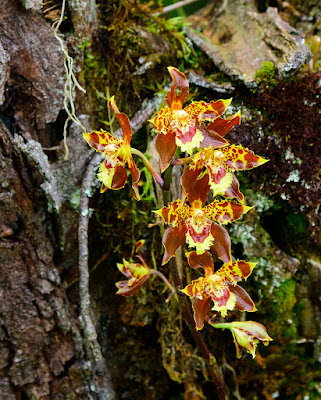Odontoglossum luteopurpureum is endemic to Colombia. It was found in wet, cold cloud forests of Andean Colombia at elevations of 2000 to 3000 meters above sea level.
Odontoglossum luteopurpureum also called as The Yellow-Purple Odontoglossum, Odontoglossum hystrix, Odontoglossum radiatum, Oncidium luteopurpureum, is a species of the genus Odontoglossum. This species was described by John Lindley in 1846.
IDENTIFY ODONTOGLOSSUM LUTEOPURPUREUM ORCHID PLANT
Odontoglossum luteopurpureum is endemic to Colombia. It was found in wet, cold cloud forests of Andean Colombia at elevations of 2000 to 3000 meters above sea level.
It is a large sized, cold growing epiphyte with robust, oval, compressed, 10-12 cm long pseudobulbs enveloped basally by 2 to 3 basal leaf bearing sheaths and carrying 2 apical, rather rigid, ensiform, acute to acuminate, 30 cm long leaves.
The Yellow-Purple Odontoglossum blooms in the spring and summer on an erect to lateral, many flowered, to 105 cm long, racemose inflorescence arising from the leaf sheaths of a mature pseudobulb and carrying up to 12, large, waxy, faintly fragrant, highly color-variable flowers. Sepals and petals nearly equal, oblong-lanceolate (the petals sometimes unguiculate), acuminate, of a rich chocolate-brown inside, with edges and tips of a greenish-yellow. Lip with a very short claw, fiddle-shaped, at its side-edges plane, its center-lobe minutely serrate and apiculate, with a multitude of finger-like processes (varying in different individuals) seated on the claw, and with their bristles all more or less inclining forwards. The upper portion of the lip is white, with a brown base, which again is banded with white beneath the series of bristles, which are of a rich golden-yellow. Column only one-third the length of the petals, slightly arched, with lacerated, hairy wings nearly concealing the anther.
ODONTOGLOSSUM LUTEOPURPUREUM ORCHID PLANT CARE AND CULTURE
Cultural information should only be used as a guide, and should be to be adapted to suit you. Your physical location; where you grow your plants, how much time you have to devote to their care, and many other factors, will need to be taken into account. Only then can you decide on the cultural methods that best suit you and your plants.
Light:
Odontoglossum luteopurpureum need a light level of 10000-15000 lux for mature plants, but less for young plants and when temperatures are high (70% shade cloth over summer and more light in winter). Leaves turn reddish blue if receiving too much light and leaf loss will occur if too sun damaged. Dark green leaves indicate insufficient light. A slight bronzing of the leaves and older bulbs indicates the light is good for flowering.
Temperature:
The Yellow-Purple Odontoglossum should be grown under cold temperature conditions. In summer, the optimum temperature range is between 8°C and 26°C. In winter, it need a minimum nighttime temperature of 4 to 7°C, with daytime temperatures of 10 to 16°C. The diurnal difference between day and night is usually 8 - 10°C. In their natural environment night temperatures can fall to 5°C and although tolerant of low temperatures down to 0°C, they will not tolerate frosts.
Humidity:
This orchid prefer humidity levels between 55-75%; higher levels of 60-80% require good air movement especially in the cooler months. Plants can also tolerate humidity levels down to 40% which can be maintained or increased with morning and evening misting.
Substrate, growing media and repotting:
Odontoglossum luteopurpureum are usually grown in pot using small bark (5-10mm) perlite potting mix (5:1) or in sphagnum moss and perlite (70:30) as substrate. Some growers place a layer of sphagnum moss on the top of the pot to reduce evaporation and keep the roots cool. They can also be grown in perlite with a layer of gravel on the top.
These plants should be repotted every year to every 2 years in spring or autumn when new growths are about half mature. They should be grown in small squat pots that allow more frequent watering. The base of the new growth should be planted about 1.5cm into the bark but no deeper. Keep bark barely moist until new roots appear then resume normal watering.
Watering:
The Yellow-Purple Odontoglossum like abundant water and require frequent watering in warmer months. They must never be allowed to dry out. During summer irrigation will be required every 2 -3 days, however during winter rates may drop to once every 10 – 14 days. Misting daily in very hot weather is recommended. To reduce leaf spotting, avoid watering in the heat of the day or late afternoon in warmer months. Also avoid wetting the leaves and water the pot, not the leaves.
Fertilizer:
This plant require frequent application of half to quarter strength fertilizer all year round but less in winter. Apply fertilizer every 2 weeks when growing actively but monthly when less active. They are not gross feeders and too much fertilizer will harm their roots and turn leaf tips brown. Use of high phosphorus or potassium fertilizers as plants approach flowering can increase flower count and substance.
Rest period:
Odontoglossum luteopurpureum do not a rest period to stimulate flowering nor in winter. But they need less water in the winter, especially if they grow under the conditions of a dark, short day that occurs in moderate latitudes. You can let the plants dry between the next watering, but you must not let the plants stay dry for a long time. Fertilization should be limited or should be completely abandoned until spring, when stronger watering resumes.















COMMENTS